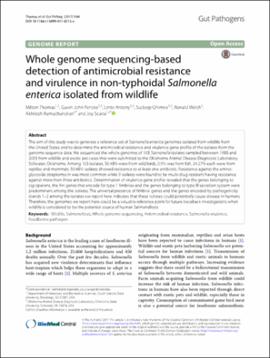| dc.contributor.author | Thomas, Milton | |
| dc.contributor.author | Fenske, Gavin John | |
| dc.contributor.author | Antony, Linto | |
| dc.contributor.author | Ghimire, Sudeep | |
| dc.contributor.author | Welsh, Ronald | |
| dc.contributor.author | Ramachandran, Akhilesh | |
| dc.contributor.author | Scaria, Joy | |
| dc.date.accessioned | 2019-09-25T18:24:41Z | |
| dc.date.available | 2019-09-25T18:24:41Z | |
| dc.date.issued | 2017-11-21 | |
| dc.identifier | oksd_scaria_wholegenomesequ_2017 | |
| dc.identifier.citation | Thomas, M., Fenske, G. J., Antony, L., Ghimire, S., Welsh, R., Ramachandran, A., & Scaria, J. (2017). Whole genome sequencing-based detection of antimicrobial resistance and virulence in non-typhoidal Salmonella enterica isolated from wildlife. Gut Pathogens, 9, Article 66. https://doi.org/10.1186/s13099-017-0213-x | |
| dc.identifier.uri | https://hdl.handle.net/11244/321436 | |
| dc.description.abstract | The aim of this study was to generate a reference set of Salmonella enterica genomes isolated from wildlife from the United States and to determine the antimicrobial resistance and virulence gene profile of the isolates from the genome sequence data. We sequenced the whole genomes of 103 Salmonella isolates sampled between 1988 and 2003 from wildlife and exotic pet cases that were submitted to the Oklahoma Animal Disease Diagnostic Laboratory, Stillwater, Oklahoma. Among 103 isolates, 50.48% were from wild birds, 0.9% was from fish, 24.27% each were from reptiles and mammals. 50.48% isolates showed resistance to at least one antibiotic. Resistance against the aminoglycoside streptomycin was most common while 9 isolates were found to be multi-drug resistant having resistance against more than three antibiotics. Determination of virulence gene profile revealed that the genes belonging to csg operons, the fim genes that encode for type 1 fimbriae and the genes belonging to type III secretion system were predominant among the isolates. The universal presence of fimbrial genes and the genes encoded by pathogenicity islands 1-2 among the isolates we report here indicates that these isolates could potentially cause disease in humans. Therefore, the genomes we report here could be a valuable reference point for future traceback investigations when wildlife is considered to be the potential source of human Salmonellosis. | |
| dc.format | application/pdf | |
| dc.language | en_US | |
| dc.publisher | BioMed Central | |
| dc.rights | This material has been previously published. In the Oklahoma State University Library's institutional repository this version is made available through the open access principles and the terms of agreement/consent between the author(s) and the publisher. The permission policy on the use, reproduction or distribution of the material falls under fair use for educational, scholarship, and research purposes. Contact Digital Resources and Discovery Services at lib-dls@okstate.edu or 405-744-9161 for further information. | |
| dc.title | Whole genome sequencing-based detection of antimicrobial resistance and virulence in non-typhoidal Salmonella enterica isolated from wildlife | |
| osu.filename | oksd_scaria_wholegenomesequ_2017.pdf | |
| dc.description.peerreview | Peer reviewed | |
| dc.identifier.doi | 10.1186/s13099-017-0213-x | |
| dc.description.department | Oklahoma Animal Disease Diagnostic Laboratory | |
| dc.type.genre | Article | |
| dc.type.material | Text | |
| dc.subject.keywords | antimicrobial resistance | |
| dc.subject.keywords | foodborne pathogen | |
| dc.subject.keywords | salmonella virulence | |
| dc.subject.keywords | salmonellosis | |
| dc.subject.keywords | whole genome sequencing | |
| dc.subject.keywords | wildlife | |
